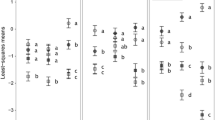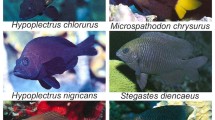Abstract
Aggressive mimicry has been proposed for several unrelated fish species both in freshwater and marine environments. I describe herein a few additional examples, including the first ones from brackish water. In one well documented case, juvenile snooks, Centropomus mexicanus (Centropomidae) join bottom-foraging groups of the superficially similar mojarras, Eucinostomus melanopterus (Gerreidae) and prey on small fishes and crustaceans under such disguise. Two other snook species and two species of groupers (Serranidae), are here suggested as additional instances of aggressive mimicry. Furthermore, I review published examples of aggressive mimicry in fishes and indicate trends in the relationships between the mimics, their feeding tactics, and their putative models. Three large families, Serranidae, Cichlidae, and Blenniidae display most of the examples of aggressive mimicry, serranids being largely represented by the genus Hypoplectrus and blenniids by the tribe Nemophini only. Three major trends are here indicated for aggressive mimics: (1) fish species that feed on prey smaller than themselves tend to mimic and join fish species harmless to their prospective prey; (2) fish species that feed on prey larger than themselves tend to mimic mostly beneficial fish species (cleaners) or, less frequently, join species harmless to their prospective prey; (3) fish species that feed on prey about their own size tend to mimic their prospective prey species, the perfect ‘wolf in a sheep's clothes’ disguise type. The latter deceit is recorded mostly for scale and fin-feeding freshwater fishes.
Similar content being viewed by others
References cited
Allen, G.R. & D.R. Robertson. 1994. Fishes of the tropical eastern Pacific. University of Hawaii Press, Honolulu. 332 pp.
Aronson, R.B. 1983. Foraging behavior of the west Atlantic trumpetfish, Aulostomus maculatus: use of large, herbivorous reef fishes as camouflage. Bull. Mar. Sci. 33: 166–171.
Brichard, P. 1978. Fishes of Lake Tanganyika. T.F.H. Publications, Neptune City. 448 pp.
Carvalho-Filho, A. 1999. Fishes: Brazilian coast, 3rd ed. Ed. Melro, São Paulo. 320 pp. (in Portuguese).
Chow, S. & P.J. Walsh. 1992. Biochemical and morphometric analyses for phylogenetic relationships between seven snapper species (subfamily Lutjaninae) of the western Atlantic. Bull. Mar. Sci. 50: 508–519.
DeLoach, N. 1999. Reef fish behavior: Florida, Caribbean, Bahamas. New World Publ., Jacksonville. 359 pp.
Diamant, A. & M. Shpigel. 1985. Interspecific feeding associations of groupers (Teleostei: Serranidae) with octopuses and moray eels in the Gulf of Eilat (Aqaba). Env. Biol. Fish. 13: 153–159.
Domeier, M.L. 1994. Speciation in the serranid fish Hypoplectrus. Bull. Mar. Sci. 54: 103–141.
Domeier, M.L. & M.E. Clarke. 1992. A laboratory produced hybrid between Lutjanus synagris and Ocyurus chrysurus and a probable hybrid between L. griseus and O. chrysurus (Perciformes: Lutjanidae). Bull. Mar. Sci. 50: 501–507.
Eibl-Eibesfeldt, I. 1959. Der Fisch Aspidontus taeniatus als Nachamer der Putzers Labroides dimidiatus. Z. Tierpsychol. 16: 19–25.
Eschmeyer, W.N. (ed.) 1998. Catalog of fishes. California Academy of Sciences, San Francisco. 2905 pp.
Froese, R. & D. Pauly (ed.). 2001. FishBase. World Wide Web electronic publication. www.fishbase.org.
Hobson, E.S. 1969. Possible advantages to the blenny Runula azalea in aggregating with the wrasse Thalassoma lucasanum in the tropical eastern Pacific. Copeia 1969: 191–193.
Hori, M. & K. Watanabe. 2000. Aggressive mimicry in the intra-populational color variation of the Tanganyikan scaleeater Perissodus microlepis (Cichlidae). Env. Biol. Fish. 59: 111–115.
Humann, P. 1992. Reef fish identification: Florida, Caribbean, Bahamas, 1st ed. Vaughan Press, Orlando. 267 pp.
Humann, P. 1994. Reef fish identification: Florida, Caribbean, Bahamas, 2nd ed. Vaughan Press, Orlando. 396 pp.
Jégu, M. & G.M. dos Santos. 2001. Mise au point à propos de Serrasalmus spilopleura Kner, 1858 et réhabilitation de S. maculatus Kner, 1858 (Characidae, Serrasalminae). Cybium 25: 119–143.
Keenleyside, M.H.A. 1979. Diversity and adaptation in fish behaviour. Springer-Verlag, Berlin. 208 pp.
Kuiter, R. 1995. The juvenile vermicular cod Plectropomus oligacanthus, a mimic of the slender maori wrasse Cheilinus celebicus. Rev. Fr. Aquariol. 21: 77–78.
Kuwamura, T. 1983. Reexamination on the aggressive mimicry of the cleaner wrasse Labroides dimidiatus by the blenny Aspidontus taeniatus (Pisces; Perciformes) J. Ethol. 1: 22–33.
Lehner, P.N. 1979. Handbook of ethological methods. Garland STPM Press, New York. 403 pp.
Loftus, W.F. 1992. Lutjanus ambiguus (Poey), a natural intergeneric hybrid of Ocyurus chrysurus (Bloch) and Lutjanus synagris (Linnaeus). Bull. Mar. Sci. 50: 489–500.
Losey, G.S. 1972. Predation protection in the poison-fang blenny, Meiacanthus atrodorsalis, and its mimics, Ecsenius bicolor and Runula laudandus (Blenniidae). Pacif. Sci. 26: 129–139.
Losey, G.S. 1974. Aspidontus taeniatus: effects of increased abundance on cleaning symbiosis with notes on pelagic dispersion and A. filamentosus. Z. Tierpsychol. 34: 430–435.
Moyer, J.T. 1977. Aggressive mimicry between juveniles of the snapper Lutjanus bohar and species of the damselfish genus Chromis from Japan. Japan. J. Ichthyol. 24: 218–222.
Myrberg, A.A., Jr. 1991. Distinctive markings of sharks: ethological considerations of visual function. J. Exp. Zool. Suppl. 5: 156–166.
Nelson, J.S. 1994. Fishes of the world, 3rd ed. John Wiley & Sons, New York. 600 pp.
Nico, L.G. & D.C. Taphorn. 1988. Food habits of piranhas in the low llanos of Venezuela. Biotropica 20: 311–321.
Nshombo, M. 1994. Foraging behavior of the scale-eater Plecodus straeleni (Cichlidae, Teleostei) in Lake Tanganyika, Africa. Env. Biol. Fish. 39: 59–72.
Ormond, R.F.G. 1980. Aggressive mimicry and other interspecific feeding associations among Red Sea coral reef predators. J. Zool., Lond. 191: 247–262.
Pietsch, T.W. & D.B. Grobecker. 1978. The compleat angler: aggressive mimicry in antennariid anglerfish. Science 201: 369–370.
Randall, J.E. 1967. Food habits of reef fishes of the West Indies. Stud. Trop. Oceanogr. 5: 665–847.
Randall, J.E. & R.H. Kuiter. 1989. The juvenile Indo-Pacific grouper Anyperodon leucogrammicus, a mimic of the wrasse Halichoeres purpurescens and allied species, with a review of the recent literature on mimicry in fishes. Rev. Fr. Aquariol. 16: 51–56.
Randall, J.E. & J.E. McCosker. 1993. Social mimicry in fishes. Rev. Fr. Aquariol. 20: 5–8.
Randall, J.E. & H.A. Randall. 1960. Examples of mimicry and protective resemblance in tropical marine fishes. Bull. Mar. Sci. Gulf Caribb. 1: 444–480.
Rivas, L.R. 1986. Systematic review of the perciform fishes of the genus Centropomus. Copeia 1986: 579–611.
Roberts, T.R. 1990. Mimicry of prey by fin-eating fishes of the African characoid genus Eugnathichthys (Pisces: Distichodidae). Ichthyol. Explor. Freshwaters 1: 23–31.
Rocha, L.A. & I.L. Rosa. 2001. Baseline assessment of reef fish assemblages of Parcel Manuel Luiz Marine State Park, Maranhão, north-east Brazil. J. Fish Biol. 58: 985–998.
Russell, B.C., G.R. Allen & H.R. Lubbock. 1976. New cases of mimicry in marine fishes. J. Zool., Lond. 180: 407–423.
Sazima, I. 1977. Possible case of aggressive mimicry in a neotropical scale-eating fish. Nature 270: 510–512.
Sazima, I. 1983. Scale-eating in characoids and other fishes. Env. Biol. Fish. 9: 87–101.
Sazima, I. 1986. Similarities in feeding behaviour between some marine and freshwater fishes in two tropical communities. J. Fish Biol. 29: 53–65.
Sazima, I. 1988. Territorial behaviour in a scale-eating and a herbivorous neotropical characiform fish. Rev. Bras. Biol. 48: 189–194.
Sazima, I. & F.A. Machado. 1990. Underwater observations of piranhas in western Brazil. Env. Biol. Fish. 28: 17–31.
Sazima, I., J. Sabino & S. Buck. 2001. Stream fishes. pp. 168–179. In: C. Leonel (ed.) Intervales, Ed. Secretaria do Meio Ambiente, São Paulo (in Portuguese).
Sazima, I. & V.S. Uieda. 1980. Scale-eating behavior in Oligoplites saurus and record of scale-eating in O. palometa and O. saliens (Pisces, Carangidae). Rev. Bras. Biol. 40: 701–710 (in Portuguese).
Sikkel, P.C. & P.D. Hardison. 1992. Interspecific feeding association between the goatfish Mulloides martinicus (Mullidae) and a possible aggressive mimic, the snapper Ocyurus chrysurus (Lutjanidae). Copeia 1992: 914–917.
Snyder, D.B. 1999. Mimicry of initial-phase bluehead wrasse, Thalassoma bifasciatum (Labridae) by juvenile tiger grouper, Mycteroperca tigris (Serranidae). Rev. Fr. Aquariol. 26: 17–20.
Springer, V.G. & W.F. Smith-Vaniz. 1972. Mimetic relationships involving fishes of the family Blenniidae. Smithson. Contrib. Zool. 112: 1–36.
Trewavas, E. 1947. An example of ‘mimicry’ in fishes. Nature 160: 120.
Thresher, R.E. 1978. Polymorphism, mimicry, and the evolution of the hamlets (Hypoplectrus, Serranidae). Bull. Mar. Sci. 28: 345–353.
Wainwright, P.C. 1988. Morphology and ecology: functional basis of feeding constraints in Caribbean labrid fishes. Ecology 69: 635–645.
Wickler, W. 1961. Über das Verhalten der Blenniiden Runula and Aspidontus (Pisces, Blenniidae). Z. Tierpsychol. 18: 421–440.
Wickler, W. 1968. Mimicry in plants and animals. McGraw-Hill, New York. 255 pp.
Widder, E.A. 1998. A predatory use of counterillumination by the squaloid shark, Isistius brasiliensis. Env. Biol. Fish. 53: 267–273.
Yanagisawa, Y., M. Nshombo, M. Nishida & Y. Niimura. 1990. Sexual dichromatism and feeding habits of the scale-eater Plecodus straeleni (Cichlidae, Teleostei) in Lake Tanganyika. J. Ethol.: 25–28.
Yamaoka, K. 1997. Trophic ecomorphology of Tanganyikan cichlids. pp. 27–56. In: H. Kawanabe, M. Hori & M. Nagoshi (ed.) Fish Communities of Lake Tanganyika, Kyoto University Press, Kyoto.
Zahorcsak, P., R.A.M. Silvano & I. Sazima. 2000. Feeding biology of a guild of benthivorous fishes in a sandy shore on south-eastern Brazilian coast. Rev. Bras. Biol. 60: 511–518.
Zander, C.D. & J. Nieder. 1997. Interspecific associations in Mediterranean fishes: feeding communities, cleaning symbioses and cleaner mimics. Vie Milieu 47: 203–212.
Author information
Authors and Affiliations
Rights and permissions
About this article
Cite this article
Sazima, I. Juvenile Snooks (Centropomidae) as Mimics of Mojarras (Gerreidae), with a Review of Aggressive Mimicry in Fishes. Environmental Biology of Fishes 65, 37–45 (2002). https://doi.org/10.1023/A:1019654721236
Issue Date:
DOI: https://doi.org/10.1023/A:1019654721236




